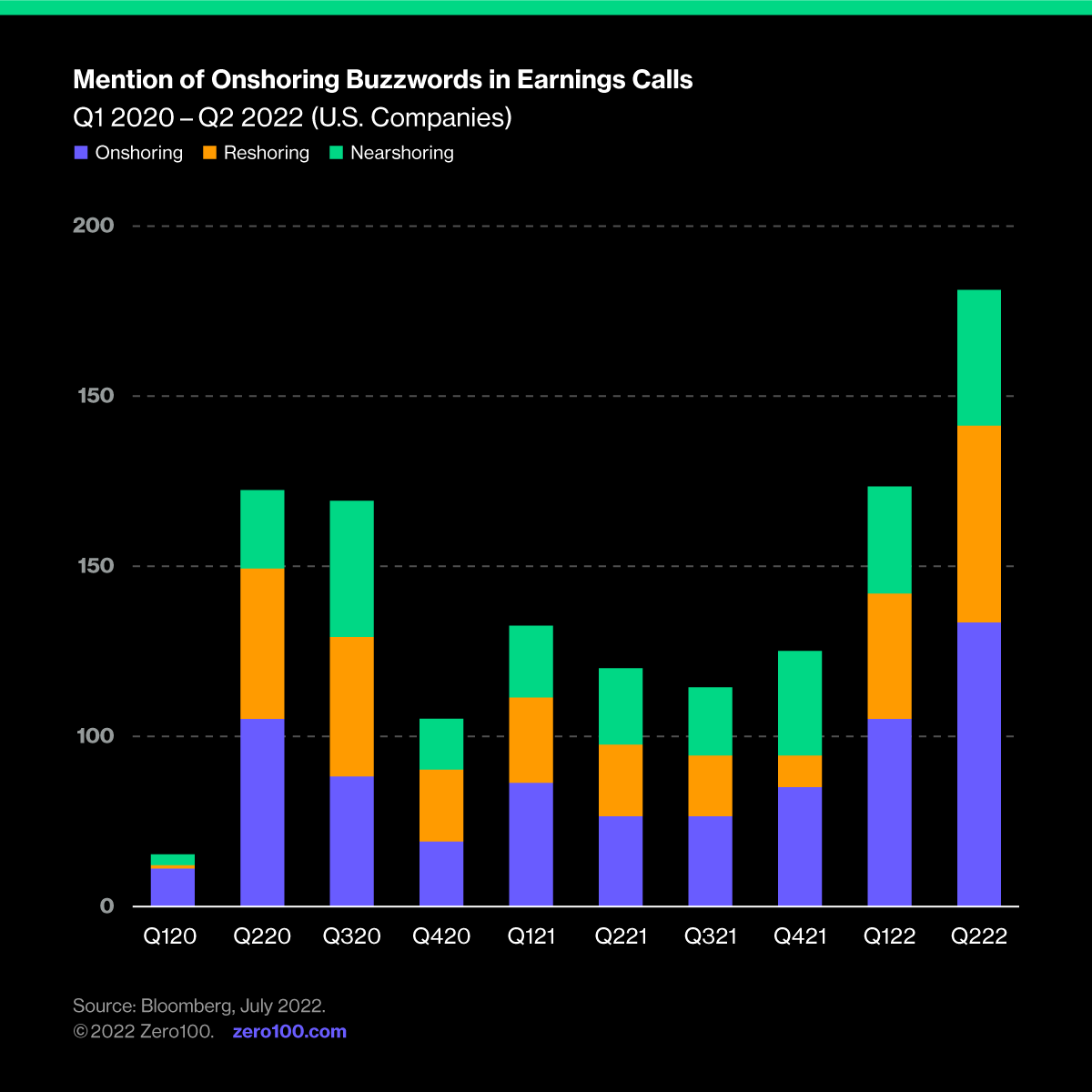
Local Supply Chains and Small Business: A Tech-Enabled Boost to Decarbonization
Carbon-heavy production and sourcing networks are giving way to shorter, greener, tech-empowered supply chains. Technology is the key enabler to retooling manufacturing closer to market – and to home.
Small businesses, stung by supply chain delays and empowered with better technology, are finally beginning to make “reshoring” a reality in the United States. The story as told by outlets like The New York Times is relatable, but misses the bigger shift away from extended, carbon-heavy production and sourcing networks to shorter, greener, tech-empowered supply chains. This shift, which builds on big companies de-risking supply by manufacturing closer to customers, is driven by business benefit, but will also be a boon for cutting carbon.

Re-Growing Your Supply Chain Roots
Back in 2013, SCM World (now a part of Gartner) published a study on strategies for optimal global manufacturing footprints. The focus was on Fortune1000 companies, and the key takeaway was that regionalized manufacturing hubs were the way forward. That has been happening, but very slowly, because factories need inputs and those inputs usually come from other factories.
It's part of a phenomenon known as “Industrial Clusters”, coined by Michael Porter of Harvard Business School to describe the way related businesses tend to cluster around important resources like parts or materials suppliers and technical talent or skilled labor. Detroit in automotive, Milan in fashion, and Taiwan in semiconductors are all industrial clusters.
Reshoring requires finding or growing an ecosystem of suppliers and talent in which to build your new factory. For big companies like Intel, Deere, Ford, and LEGO this is difficult, but doable. For small businesses, especially those who grew up selling direct to consumers on Shopify or Amazon, it has been much harder because many are ‘design-and-sell-only' relying for manufacturing on the biggest Industrial Cluster of all time, China. These companies often have no production ecosystem at all in the US, and little idea of how to grow one.
Better Tech Tools to Build Local Supply Chains
Finding materials, components, equipment, and people locally for everything that had been done in China is complicated, to say the least. But backing up a few steps and rethinking product designs, material specs, and fabrication process has worked for the small businesses, like those featured in NYT's article. What is new however, is the expanded role of technology in rethinking and retooling manufacturing to fit the local ecosystem.
Three classes of technology have advanced massively in recent years to make a difference:
- Collaboration platforms – This category includes everything from e-commerce systems built by industrial distributors like Grainger, WESCO, and Winsupply to crowd-sourcing platforms like Mechanical Turk, APPEN, and MicroWorker. Ten years ago, when Chinese manufacturing was still relatively new and incredibly cheap, the alternative of searching for suppliers, capabilities, and contract work on the internet was weak. So much has been added in terms of search logic, AI help-bots, CAD model sharing and collaboration functionality like videoconferencing that finding the pieces of your local industrial cluster is dramatically easier now.
- Materials and manufacturing technology – Additive manufacturing was literally a hobbyist fantasy ten years ago, with serious applications limited to big, tech-rich companies like General Electric and Hewlett Packard. Now, with dozens of 3D printing equipment makers past startup stage, small business has options for making essential tooling like plastic molds or production parts with oddball geometries. Similar trends are underway with robotics, where equipment costs keep coming down as capabilities keep advancing. And possibly, even more important, billions have been poured into material science startups which might free some small companies from dependence on big, remote producers of resins, fabrics, and specialty chemicals.
- Engineering, design, and simulation tools – High-powered CAD systems were once used mainly by big companies in engineering-heavy sectors like automotive, aerospace, and industrial infrastructure. Time, competition, and the onward march of Moore's Law, however, has radically improved and democratized access to these kinds of tools. Small manufacturers needing to re-design their products around parts or features that are impossible to find outside of China can now do it faster and more precisely than ever before.
Digitization Eases the China Divorce for Small Business
COVID is closing the door on Chinese manufacturing as a panacea for entrepreneurs with good product ideas, but no factory. Luckily, digitization is helping to re-shore production for these businesses.
Stay home, embrace tech, and re-invent your supply chain for a low-carbon world.
Critical Reading
TECHCRUNCH
Ambi Robotics Secures $32M Infusion to Deploy Its Item-Sorting Robots in Warehouses
Commentary: Ambi Robotics primarily focuses on automating logistics and fulfillment processes. Using techniques of training robots through an AI system discovered by the company's founders years ago, Ambi “teaches” their robots to pick and pack millions of unique items on the fly.
#robots #logistics
THE WALL STREET JOURNAL
Fast-Fashion Juggernaut Shein's Sales Close in on Zara, H&M
Commentary: Shein's unique business model, which allows it to respond quickly to shifting fashion trends and sell at ultra-low prices online only, has enabled the company to establish itself as a major rival to Zara and H&M, major fashion retailers which sell both in stores and online.
#retail #fastfashion
GREENBIZ
Is the Corporate World Approaching a Climate Disclosure Tipping Point?
Commentary: Environmental disclosure is now a mainstream activity for many corporates across the world, this year's annual CDP report confirms. The report shows a 38% increase in the number of organizations that disclosed their climate and environmental data from 2021 to 2022.
#climate #data